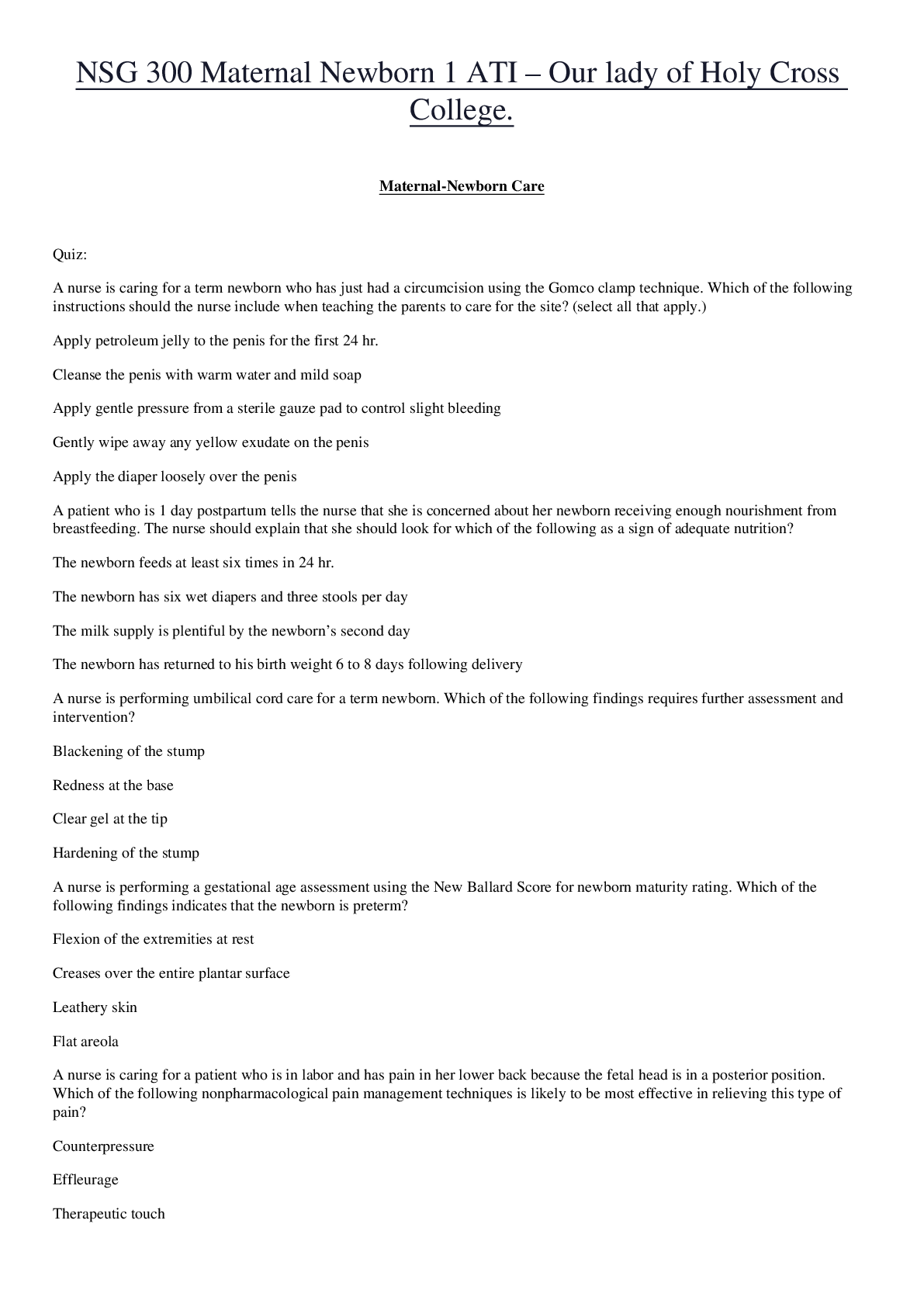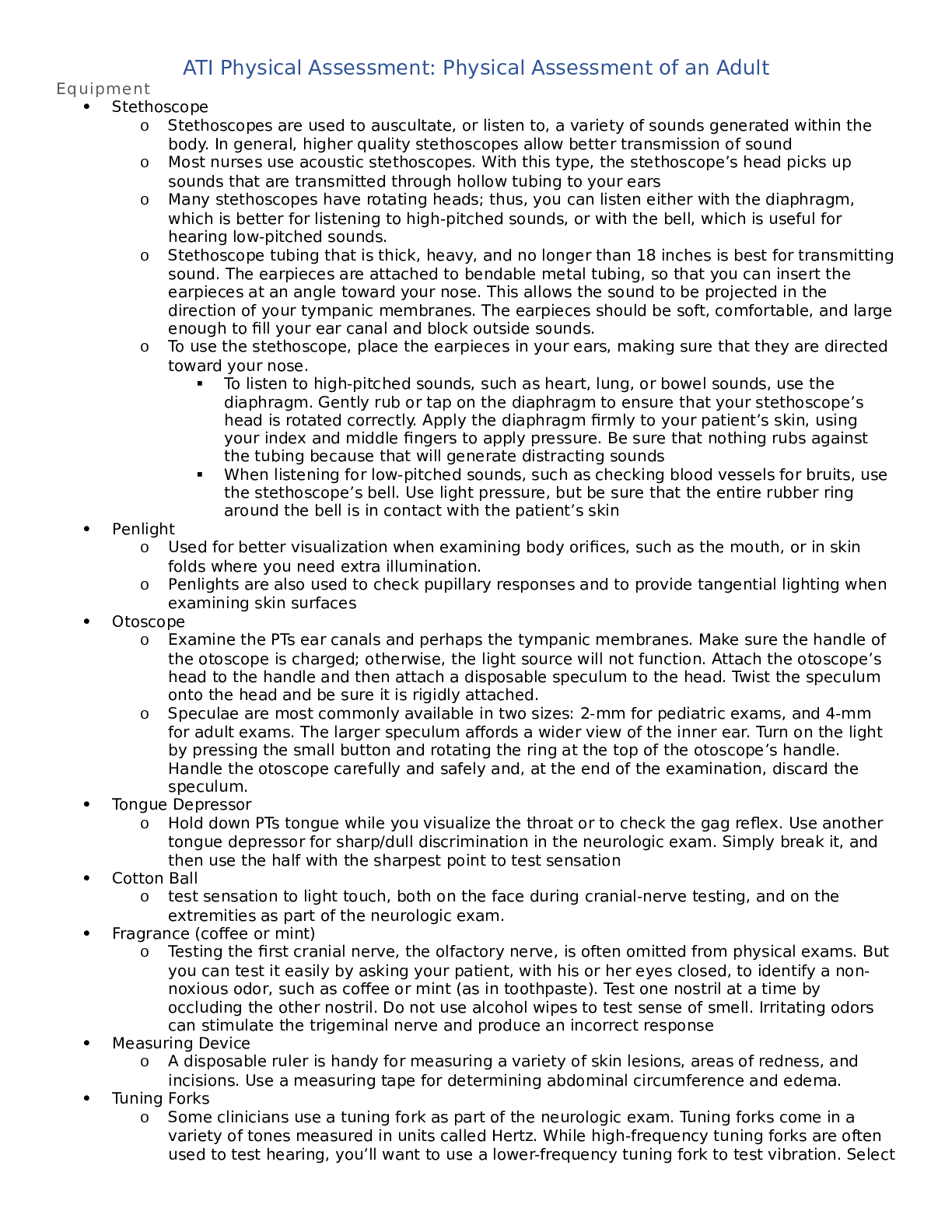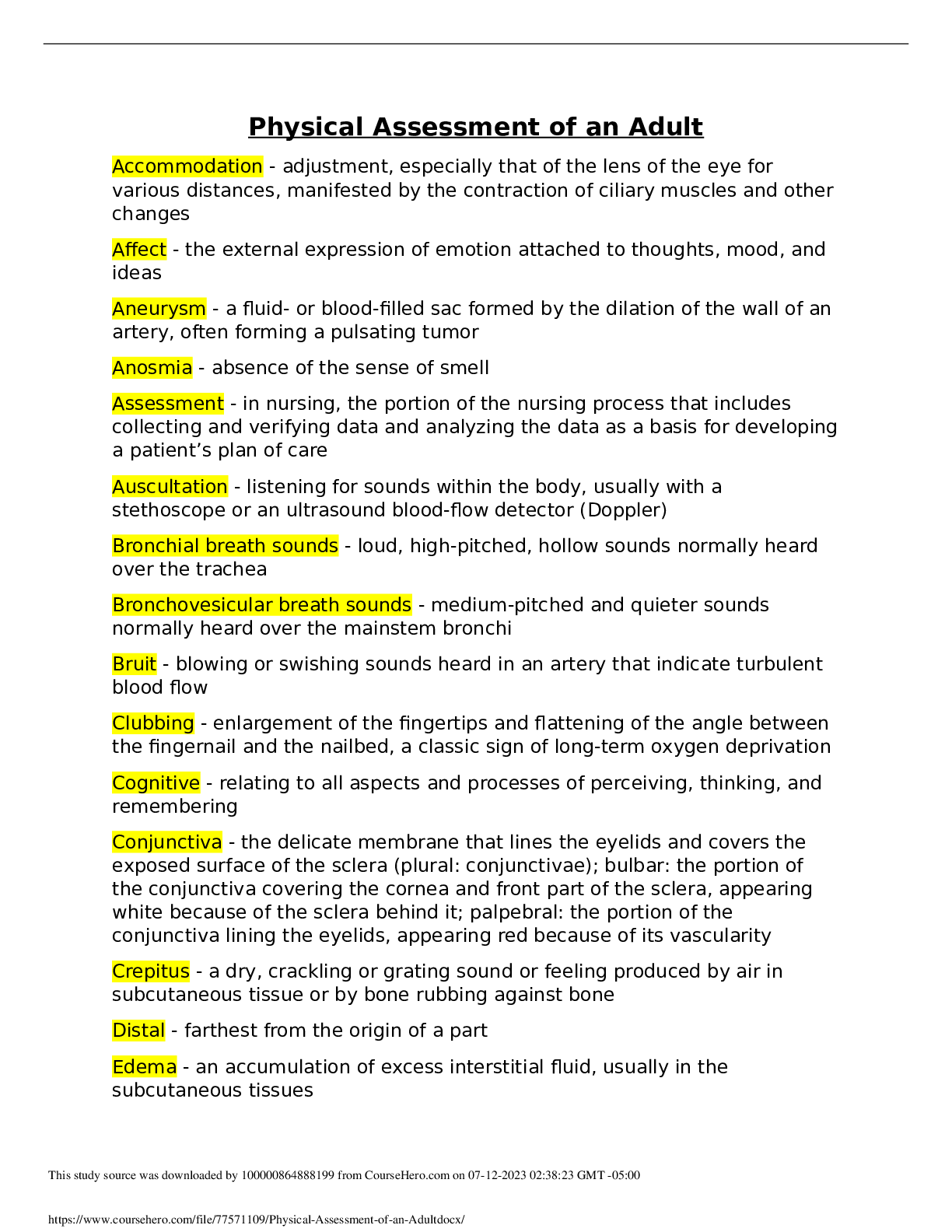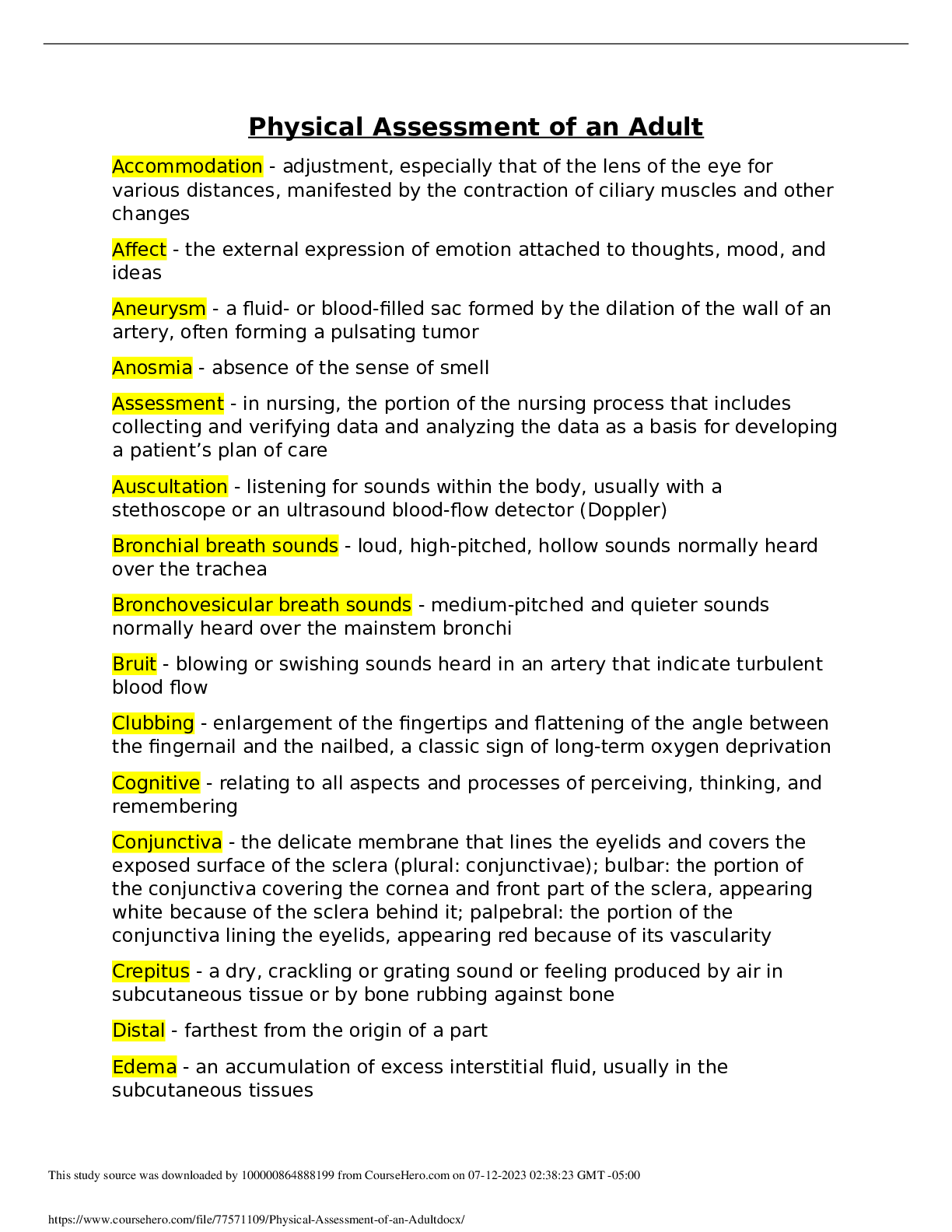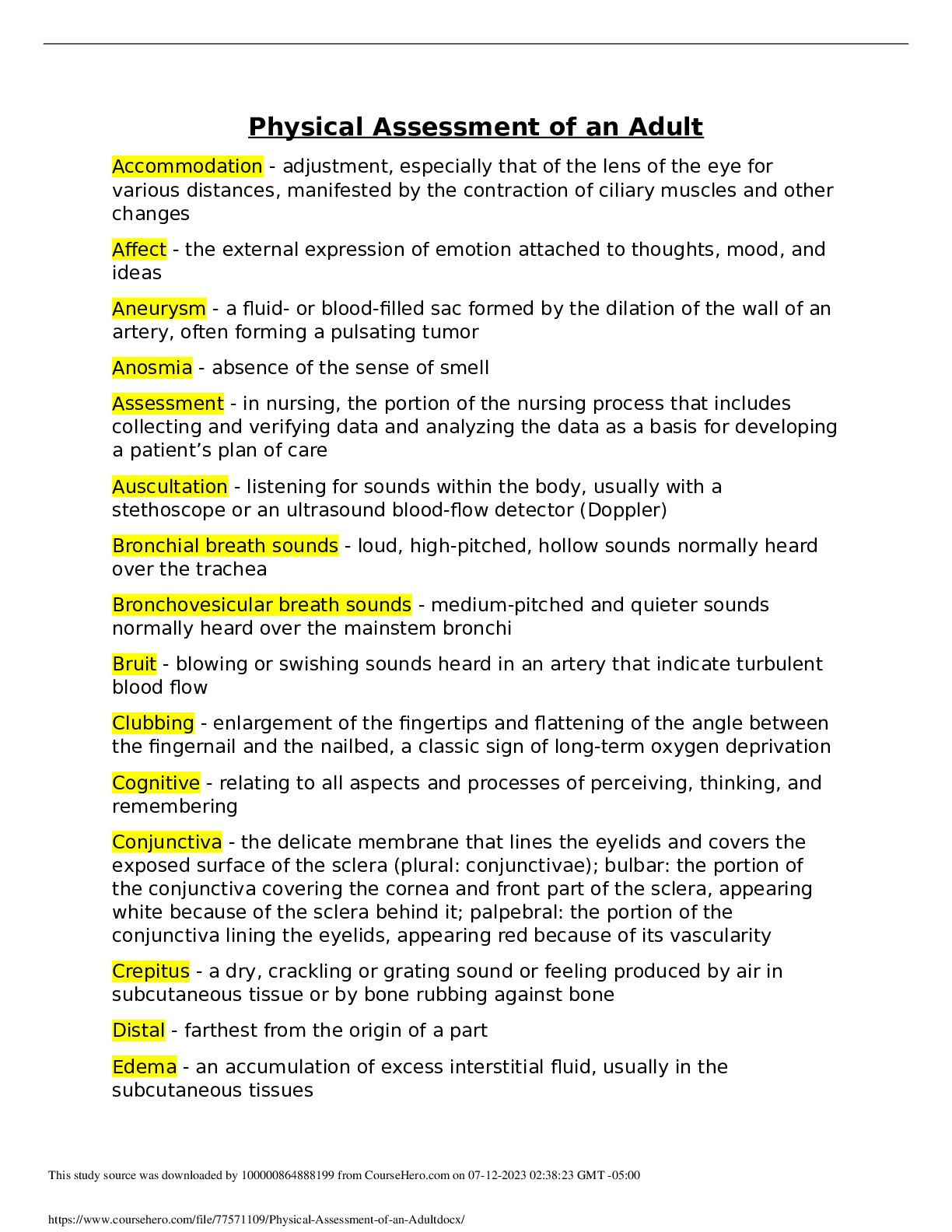*NURSING > EXAM > NSG 300 Physical Assessment of Child ATI – Our lady of Holy Cross College / NSG 300 Physical Asses (All)
NSG 300 Physical Assessment of Child ATI – Our lady of Holy Cross College / NSG 300 Physical Assessment of Child ATI
Document Content and Description Below
NSG 300 Physical Assessment of Child ATI – Our lady of Holy Cross College Physical Assessment of Child Quiz: 1. A nurse is documenting findings from a physical examination. Which of the foll... owing statements indicates correct charting? a. “Bowel gurgling at 24 per minute, heard in left upper quadrant, right upper quadrant, left lower quadrant, and right lower quadrant.” b. “No problems breathing. Lungs clear.” c. “liver palpation is normal.” d. “regular heart rate and rhythm: S1, S2 heard” 2. When performing an otoscopy examination on a 2-year-old child, the nurse should pull the pinna a. Down and back b. Down and forward c. Up and back d. Up and forward 3. A nurse is testing a child for strabismus. Which of the following is correct technique for performing this examination? a. Check for presence of the red reflex b. Check for visual acuity c. Perform the cover-uncover test d. Test for pupillary reaction to light 4. When assessing a school-age child or adolescent for scoliosis, it is important to have the child a. Bend the knees and touch the toes b. Stand up straight with arms at the side c. Bend forward with knees straight and the arms dangling d. Lie prone with the arms extended 5. A nurse is performing an annual physical examination on an adolescent. Which of the following should be included in the general survey? a. The patient’s deep tendon reflexes are 2+ bilaterally b. The patient is able to read small print at 14 inches c. The patient demonstrates short-term recall d. The patient makes good eye contact 6. Which of the following communication techniques is most appropriate for a nurse to employ during the physical examination of a 10-year-old? a. Allow the child to play with the equipment b. Encourage expression of thought through puppets c. Use books and other visual aids to advance the interview d. Use abstract questions to allow the child more freedom in response 7. A nurse is examining an 18-month-old child’s ears during a well-child visit. Which of the following techniques should the nurse use? a. Position the child on his side and have the parents hold the arms and head down b. Have the parent hold the child securely in her lap c. Ask another nurse to come into the room and hold the child d. Restrain the child using a blanket to secure his arms against his sides. 8. A nurse is obtaining a problem-oriented history from a preschool-age child. The nurse should consider that children from this age group typically can. a. Describe symptoms b. Identify when the problem started c. Specify the cause of the problem d. Answer questions related to previous health problems 9. Which of the following techniques is appropriate when obtaining a blood pressure on a child? a. Position the arm below the level of the heart while the child is sitting in a chair. b. Release the cuff pressure at a rate of 4 to 5 mm Hg. c. Inflate the blood pressure cuff slowly d. Use a cuff with a bladder covering 80 to 100% of the arm circumference 10. A nurse is performing an abdominal examination on a preschooler. Which of the following instructions should the nurse give to the child when performing abdominal palpation? a. Hold your breath b. Place your hand under mine c. Turn on your right side d. Raise your arms over your head Equipment: • Stethoscope • Penlight • Otoscope (examine patient’s ear canals) • Ophthalmoscope (examine internal eye structures) • Tongue depressors • Cotton ball • Fragrance • Measuring devices Pediatric Perspective • Engage the parent and the child • Organize your examination o Least invasive procedures first • Involve the child o Play games to help relax the child o Try speaking in third person o Explain each part of the examination to the child o Encourage the child to ask questions o Try to teach the child as best you can • Keep a steady pace • Be honest o Do not offer choices if there are none o Praise the child before, during, and after each step. o If the child does not cooperate, see if the parent can help • Age by Age: o Infants ♣ Nonverbal activities in communication • Holding, rocking, and patting ♣ Talk in a quiet, unhurried, nonthreatening tone of voice. ♣ Watch how the parents interact to pick on up established forms of communication ♣ With older infants it might be easier to have the parent hold the child ♣ Have infant hold favorite toy or object ♣ Be playful with infant to promote a quick, efficient, thorough, and nontraumatic examination. o Toddler ♣ A toddler expresses herself through a broad range of nonverbal actions; observe these and take cues from the parent-toddler interaction you observe earlier ♣ Look for signs of fear and anxiety; if anything is noted address it immediately in a soft relaxed manner ♣ Use short concrete instructions and repeat them several times ♣ Make up engaging scenarios (superhero muscles) ♣ Use dolls to help explain the procedure (even let the child demonstrate the procedure) ♣ Let child touch and play with equipment before the examination o Preschooler ♣ Communication skills used for toddlers work for this age group ♣ Ask parents to assist if child becomes uncooperative ♣ Encourage them to ask questions ♣ Allow them to undress themselves for the examination ♣ Make responses short, specific, and in simple language ♣ Introduce proper terminology of body parts to children ♣ Rewards (stickers, small toys) o School-age ♣ May have had prior experience (need to know whether they were positive or negative) ♣ Explain every step of the examination ♣ Respond well to reassurance and praise ♣ Talking in third person can be very effective ♣ Explain in simple terms the various parts of the examination and why you are doing each step ♣ Responds well to discussion about what you are doing as you do it o Adolescents ♣ Understand prior experiences with healthcare visits ♣ Address fears verbally and directly ♣ Expect the adolescent to use monosyllabic responses plus a wide range of nonverbal expressions ♣ Be patient, do no pry ♣ Refocus the discussion if it is no proceeding well ♣ Try to do part of the examination and history taking without the parent in the room (allows them to talk about sensitive issues) ♣ Determine the child’s comprehension level ♣ Ask child to reiterate what you have said in their own words to confirm they understand General Patient Survey and Anthropometric Measurements • General patient survey o Take note of the child’s general appearance and behavior ♣ Should appear well nourished and developed for their age o Be sure to note the child’s facial expression as well ♣ Any signs of pain or distress o Note the behavior and tone of voice the parent uses with the child ♣ Is the interaction between them warm and caring and appropriate? o Observe hygiene, grooming, and dress o Note the child’s mood. • Anthropometric measurements o Important to plot their weight, height, and head circumference on the appropriate growth chart. o Two types of charts ♣ 0-36 months ♣ 2-20 years o each child is plotted on a curve and they should follow that curve consistently throughout adolescents o measurements fall within the 5th and 95th percentile are considered normal range • Weight o Infants ♣ Weight on a platform type scale with clothes and diaper removed ♣ Calibrate the scale prior to weight ♣ Place a clean cloth or disposable pad over the scale ♣ Weigh to the nearest half ounce and record on the appropriate flow sheet o Toddlers/Preschoolers/School-age children ♣ Use an upright scale if appropriate for the child ♣ Take off shoes, jackets, or coats ♣ Weight to the nearest ¼ pound and record on appropriate flow sheet o Adolescents ♣ Upright scale to obtain weight and height ♣ Have child wear as little clothing as possible ♣ Look for symptoms of eating disorders • Height/Length o Infants [Show More]
Last updated: 2 years ago
Preview 1 out of 59 pages
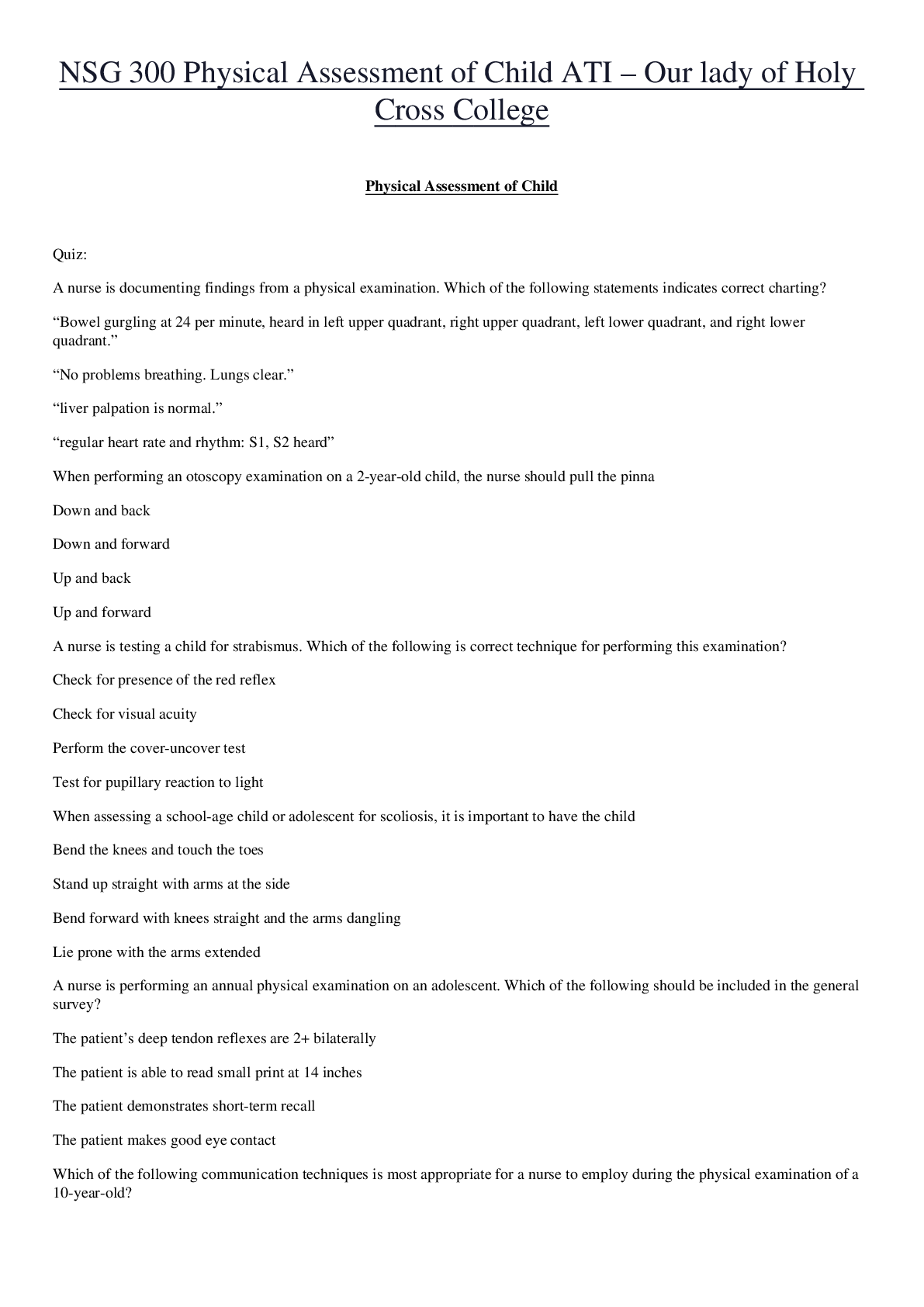
Buy this document to get the full access instantly
Instant Download Access after purchase
Buy NowInstant download
We Accept:

Reviews( 0 )
$18.00
Can't find what you want? Try our AI powered Search
Document information
Connected school, study & course
About the document
Uploaded On
May 26, 2020
Number of pages
59
Written in
Additional information
This document has been written for:
Uploaded
May 26, 2020
Downloads
0
Views
117








 – University of the People.png)






